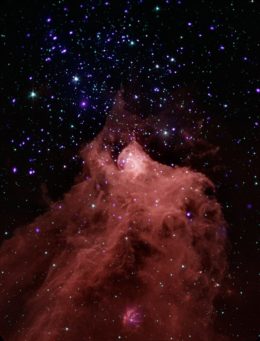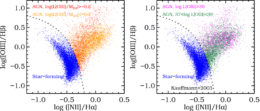
Clouds of cold gas, like Cepheus B shown here at infrared (red, blue, and green) and X-ray (violet) wavelengths, provide the fuel for star formation. [X-ray: NASA/CXC/PSU/K. Getman et al.; IR: NASA/JPL-Caltech/CfA/J. Wang et al.]
Stymied Star Formation?
Stars form from cold, dense hydrogen gas. Any process that heats this gas, disperses it, or makes it turbulent has the potential to disrupt the star-formation process. For this reason, astronomers have long suspected that the radiation and particle jets from active galactic nuclei — extremely luminous galactic centers powered by a supermassive black hole accreting matter — can inhibit star formation in the galaxies they inhabit.
If this is the case, galaxies with active galactic nuclei should have smaller reservoirs of cold, star-forming hydrogen gas than those without, either because the gas has been heated up or blown away. However, searches for a decline in cold gas have so far come up short. Can a new analysis find trends that have gone unnoticed in previous studies?
Grouping Galaxies
A team led by Hong Guo (Shanghai Astronomical Observatory, China) analyzed a massive sample of galaxies observed by the Sloan Digital Sky Survey and Arecibo Observatory to determine what effect — if any — the presence of an active galactic nucleus has on the host galaxy’s supply of cold, star-forming gas. Guo and collaborators grouped the >10,000 galaxies in their sample according to their masses, star-formation rates, and luminosity of their active galactic nuclei.

Separation of the sample into galaxies with and without active galactic nuclei. The classification is shown according to the Eddington parameter (ratio of luminosity and black hole mass) on the left and according to the luminosity on the right. Click to enlarge. [Guo et al. 2022]
A High-Mass Hypothesis

Active galactic nucleus (AGN) hosting galaxies with masses up to 10 billion solar masses have less star-forming gas available than galaxies without AGN (left column). This trend is not robust among more massive galaxies (center and right columns). Click to enlarge. [Guo et al. 2022]
As to why only the galaxies in the lowest mass bin showed this behavior, Guo and coauthors suggest that high-mass galaxies may simply be too large for their entire reservoir of cold gas to be heated or disrupted while the active galactic nucleus is “on.” In this case, an active galactic nucleus might have a large impact on the inner regions of the galaxy, but that impact may not extend far enough out to be observed. Future high-resolution surveys of cold gas should illuminate this issue further, especially in low-mass galaxies where active galactic nuclei have an outsize impact.
Citation
“Cold Gas Reservoirs of Low- and High-mass Central Galaxies Differ in Response to Active Galactic Nucleus Feedback,” Hong Guo et al 2022 ApJL 933 L12. doi:10.3847/2041-8213/ac794f
